Baroque in Glasgow - JR Rhind
The most striking of the libraries constructed with Carnegie's 1901 gift to Glasgow were designed by the Inverness architect, James Robert Rhind.
Although James Rhind did not live or work in Glasgow, he was remarkably successful in the competition for the city's new libraries.
His designs were selected for 7 of the original 12 libraries, with 5 of them being in the Baroque style which was not at all common in Scotland at the time.
Rhind’s extravagant use of columns, domes and statues brightened up many of the overcrowded dreary districts of the city where the new branches were located.
The recessed windows and entrances of his libraries skilfully emphasise the shadows on the facades. Rhind's previous notable buildings had all been in the north of Scotland, the Royal Golf Hotel, Dornoch, in 1897 and the Crown Church, Inverness, in 1901. For a short period in 1904/5, while he was involved with the construction of new libraries, Rhind occupied offices in Hope Street in Glasgow city centre. He remained a fellow of the Glasgow Institute of Architects until 1914.
Woodside Library, Glasgow.
Woodside library was the first of J.R.Rhind’s libraries to be completed. The Glasgow Herald of 11th March 1905 quoted the architect's remarks at the opening ceremony, regarding his competition winning design. In the stilted style of his time, Rhind "ventured to think that both as regards the front elevation and the general plan and internal arrangements they would be disposed to justify his selection".
The library façade has attractive arched windows with fluted Ionic columns either side. Similar paired columns flank the doorway. There is a huge glazed roof over the main library area, which, along with the tall windows, gives it abundant natural light.
Dennistoun Library, Glasgow.
Rhind's second library, in Dennistoun, to the east of the city centre, is a two-storey Baroque building with a very decorative façade. It is cleverly scaled, fitting neatly into the site with prominent bays at either end. The south bay is capped with a neatly proportioned sandstone dome.
There are numerous small details, carvings and statues to add to the total effect.
Govanhill Library, Glasgow.
With this single storey building, Rhind continued with the elaborate Baroque styling of the similar library in Dennistoun which had opened three months earlier.
Bridgeton Library, Glasgow.
This two-storey building has a long curved frontage with pedimented bays placed at either end. There is an abundance of Baroque inspired ornamentation on the façade, which is worthy of close inspection for small detail as well as for larger features.
Parkhead Library, Glasgow. This two-storey red sandstone library was built to a well proportioned asymmetrical design with a dome over the north-west corner.
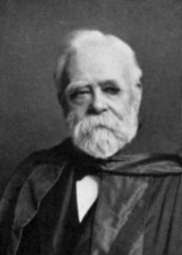
Francis Thornton Barrett (left) was Glasgow's City Librarian from 1877 to 1915, throughout the whole period of the introduction of the Carnegie libraries to the city.
Barrett had been given the responsibility of forming a system of branch libraries for Glasgow and had supervised the architectural competition in which Rhind submitted his design proposals for the buildings.
The libraries were mostly built in areas of high-density tenement housing where Rhind's distinctive monumental style successfully created local landmarks rather than mere depositories of books.


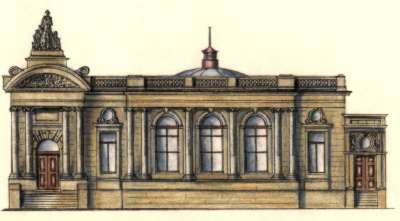
Opened 10th March, 1905
Woodside was the largest of the Carnegie libraries of Glasgow, both in terms of floor area and the number of volumes held, reflecting perhaps the need for increasing budgetary control as the building programme progressed, as much as the size of population served in the district.
Its current use remains as a branch library.

The library had been officially opened by the local councillor, Daniel.M.Stevenson (right), who had made a considerable contribution to establishing libraries in the city, from as early as 1896.
Stevenson had toured the library systems of Edinburgh, Manchester, Liverpool and Birmingham to prepare a report for the Corporation prior to planning Glasgow's libraries.
Many years later in 1913, while he was Glasgow's Lord Provost, Daniel.M.Stevenson spoke of the success of the nearly completed scheme of district libraries, boasting that they had enjoyed a total attendance of 7,250,000 the previous year.
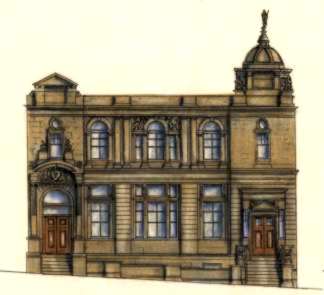
Opened 29th December, 1905
The front of this library gives a strong three-dimensional impression, showing great depth and shadow.
Its current use remains as a branch library.
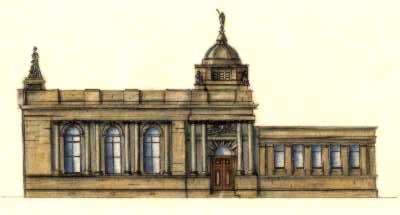
Opened 16th March, 1906
Situated on a busy corner, the library displays edifices to both Langside Road and Calder Street with the main entrance at Langside Road having a sandstone dome topped with a bronze statuette over the recessed doorway.
The Calder street façade features two groups of statues representing the personification of knowledge, with matronly figures reading to groups of children.
Both frontages have high arched windows with coupled Ionic columns either side.
Its current use remains as a branch library.
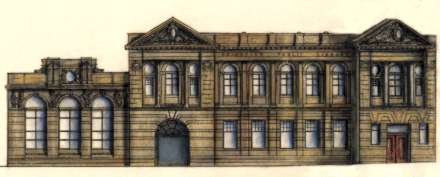
Opened 17th May, 1906
The single storey reading room at the northern end of the library has very attractive arched windows facing into the street.
Its current use remains as a branch library.
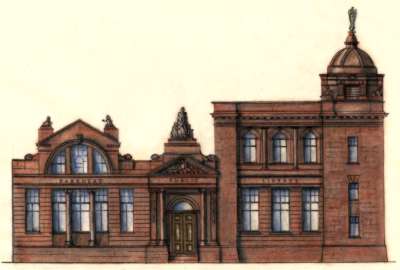
Opened 6th August 1906
The central entrance has a pedimented portico with Ionic columns flanking the doorway and a group of statues above.
The façade remains intact, although internally the building was modernised and made "open plan" in 1984 without major damage to the original layout.
Its current use remains as a branch library.
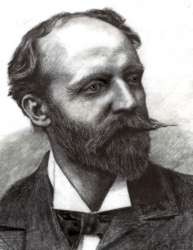
The library had been officially opened by Councillor James Shaw Maxwell (right)who was one of the early instigators of free libraries for Glasgow. As far back as September 1896, Maxwell had chaired a meeting of public bodies with an interest in free public libraries, such as the Co-operative Societies and the Glasgow Trades Council as well as educational groups such as the Teachers Association and Educational Institute.
Shaw Maxwell had brought various motions before the Corporation in 1897 and 1898 to have the Libraries Acts adopted, before the matter was finally resolved by applying to Parliament for a special Act.
Carnegie Libraries of Scotland: Architecture & History

 Introduction
Introduction
The Carnegie Libraries
 Andrew Carnegie
Andrew Carnegie
His Scottish connections
 Early Carnegie Libraries
Early Carnegie Libraries
The first in the world
 American Libraries
American Libraries
A comparative study
 Scottish Architecture
Scottish Architecture
Unique libraries
 Renaissance
Renaissance
Edwardian architecture
 Baroque
Baroque
J.R. Rhind in Glasgow
 Library Architecture
Library Architecture
Diverse designs
 Inside the Libraries
Inside the Libraries
Photographs from 1907
 Carnegie Hero
Carnegie Hero
John Blaikie in 1911
 Exhibition
Exhibition
Landmarks of Literacy